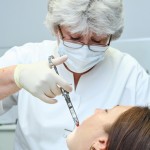
Acute irreversible pulpitis is an extremely unpleasant and distressing experience for the patient which can be challenging for the dentist to manage without causing further pain. The acutely inflamed pulp is more acidic, reducing the amount of basic anaesthetic available to penetrate the nerve membrane and block sodium channels. Coupled with the increased expression of sodium channels due to local prostaglandin release, it is more likely that enough sodium channels will remain open to allow pain signals to be transmitted along these nerves. The clinical result is anaesthetic failure. Typically, 2% lidocaine with adrenalin given as an inferior alveolar nerve block (IANB) has been considered the gold standard.
The authors of this network meta-analysis (NMA) sought to find out which technique and drug is the most efficacious and safe for achieving pulpal anaesthesia for non-surgical endodontic treatment for cases of irreversible pulpitis affecting molar teeth when compared to a 2% lidocaine IANB.
Methods
The authors used a NMA technique in order to rank multiple interventions for the same clinical problem (symptomatic irreversible pulpitis) even where no direct comparison in a clinical has been undertaken.
As with any type of systematic review, a comprehensive literature search is required. The review authors searched Medline, Embase, Cochrane Central, CINHAL and Scopus for potentially relevant studies. In addition, the authors comprehensively searched for gray literature, unpublished and ongoing studies as well as relevant conference abstracts and handsearching of reference lists.
Only RCTs of adults undergoing non-surgical endodontic treatment were included. Studies which did not assess the outcome of “successful pulpal anaesthesia” were excluded as were studies using anaesthetic formulations uncommon in the USA and those with aggregate results for molars and premolars. Two reviewers assessed for eligibility, risk of bias and quality. Bayesian NMA was conducted in program R using a hierarchical random effects framework. The treatment effects were estimated as odds ratios.
Results
- 46 RCTs assessing 37 interventions and involving 5095 patients were included
- 23 studies were graded as low risk, 20 as moderate risk and 3 as high risk of bias.
- The most common technique was IANB followed by Gow-gates, Vazirani-Akinosi, buccal infiltration (+/-lingual infiltration) and intraligamentary injection.
- The most common supplemental techniques (i.e. in addition to IANB) were buccal infiltration, intraligamentary, intra-osseous and Gow-Gates.
- Studies also investigated changing the drug and various premedications including NSAIDS, paracetamol and opioids.
- 2632 of 5094 (52%) patients had successful pulpal anaesthesia during treatment.
- Compared with conventional IANB along, the most effective supplemental techniques were
- Supplemental intra-osseous injection using 2% lidocaine and pre-operative NSAIDS combined with paracetamol (OR=74). Very low confidence.
- Supplemental intra-osseous injection using 2% lidocaine and pre-operative NSAIDs alone (OR=46). Very low confidence.
- Supplemental intra-osseous injection using 2% lidocaine. (OR=33) moderate confidence.
- Supplemental intra-osseous injection using 2% lidocaine and pre-operative opioids combined with paracetamol (OR=20) Very low confidence.
- Supplemental intra-osseous injection using 4% artcaine (OR=20) very low confidence.
- The majority of studies did not report major safety concerns or did not provide any data on safety.
Conclusions
The authors concluded that
Very low to moderate quality of evidence suggests supplemental intra-osseous injections using 2% lidocaine or 4% articaine…are the most efficacious interventions to achieve successful pulpal anaesthesia during endodontic treatment of mandibular molars with symptomatic irreversible pulpitis according to the current literature.
Comments
The fact that 37 different interventions were identified in 46 trials demonstrates the lack of consensus surrounding how best to manage the irreversibly inflamed pulp in lower molars. Unfortunately, this NMA shows that the quality of evidence to support our clinical choice of LA drug, premedication and technique is low. Further, well-designed and sufficiently large RCTs are needed to test the most promising interventions in the real world.
So what can be applied to the clinic from this review? Well, the authors highlight the finding that giving more than one cartridge of the same drug using the same technique is unlikely to lead to success in cases of symptomatic irreversible pulpitis. Since that is the case, the available evidence suggests that supplementing an IANB with intra-osseous administration of either 2% lidocaine or 4% articaine may be the most effective.
Links
Primary paper
Other references
Dental Elf – 8th Nov 2019
Dental Elf – 1st Mar 2019
Dental Elf – 27th Jan 2017
